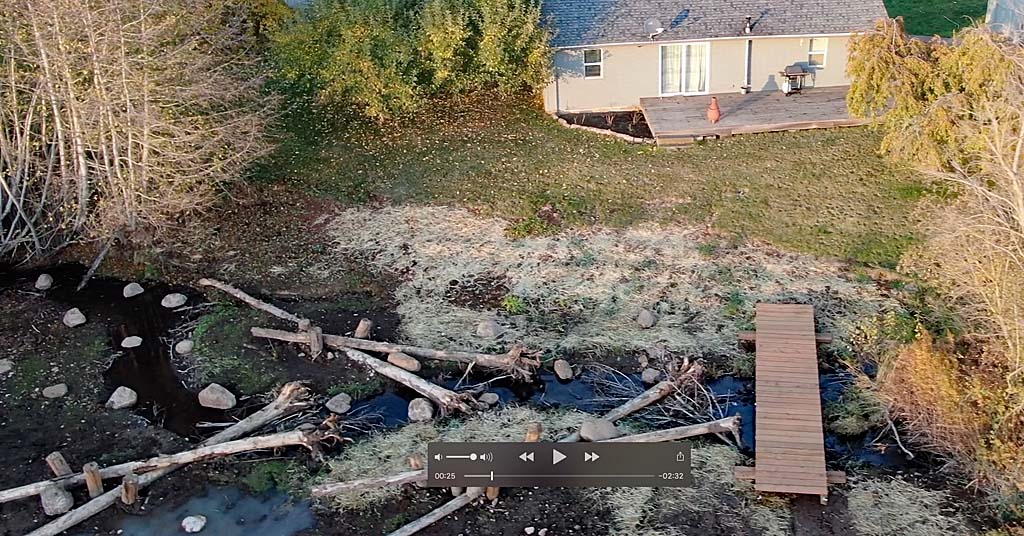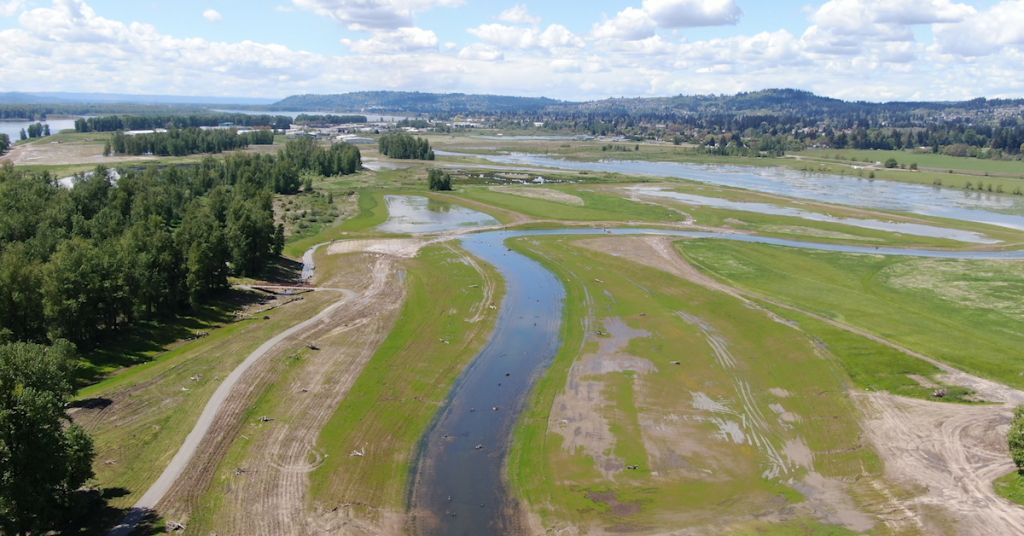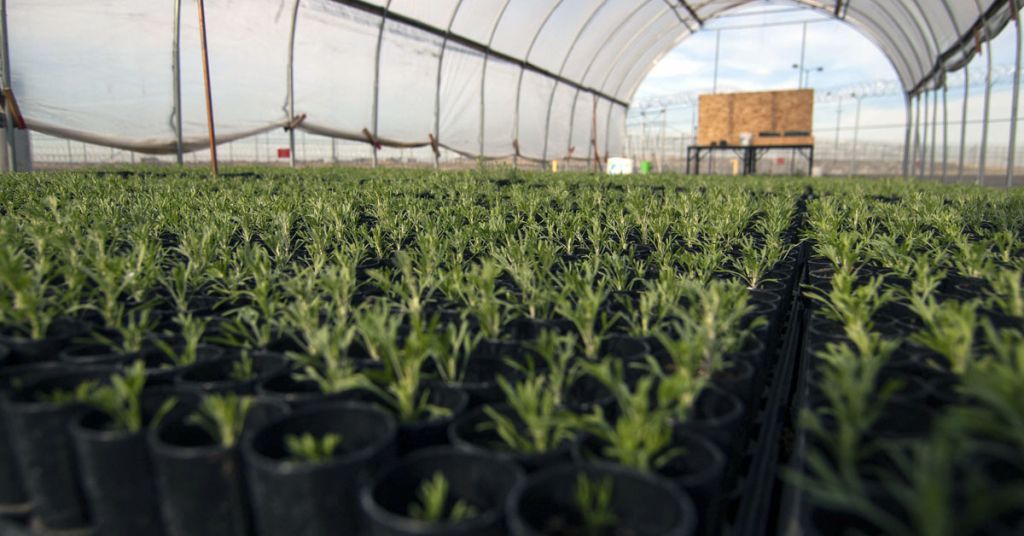
One of the only small areas of beach with legal access under the train tracks. Covered with graffiti in recent years.
Story and photos by Miko Ruhlen. July 20, 2017. Recently, I realized that I take for granted public access to natural areas. Now National Monument protection designations are under review. Affordable housing competes with parks and open space. Park maintenance and enforcement funds are often unavailable. Some trails and native habitat restoration projects are only possible because of hard working volunteers.
And people. I run into more and more people on trails and beaches. That means more road and trail maintenance. Greater frequency of restroom and trash can maintenance. With the same amount of staff time. More dog poop. More litter. More vandalism.
I drove down to the old powerhouse on the Hood River last month. A favorite bird watching spot that I hadn’t visited in a couple years. Potholes in the road have increased in number and depth. The port-a-potty and garbage cans were gone. Graffiti covered every sign. I came to commune with nature, but it felt like the entrance to an urban jungle.
Access to the Powerdale Corridor is complicated.
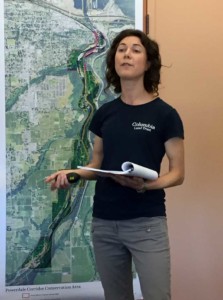
Kate Conley of Columbia Land Trust presents at a public meeting at the Hood River Library June 27
“If we don’t do anything, we will see a loss of public access over time,” said Kate Conley of Columbia Land Trust at a public meeting June 27, 2017 to present the Powerdale Recreation and Access Plan. With increased use of natural areas, and decaying infrastructure, owners and managers find it increasingly difficult to balance recreation, restoration, and responsibility in the Powerdale Corridor in Hood River.
The Powerdale Conservation Corridor is a narrow band of land bordering the lower Hood River from the former powerhouse and upstream about 3.5 miles including the former dam site. In March 2013, after removal of the Powerdale dam, approximately 400 acres of property was transferred from PacifiCorp to Columbia Land Trust (300 acres) and Hood River County (100 acres). While diverse habitat was gained by the Land Trust for conservation purposes, they also inherited complications with recreation use and access.
The Powerdale Lands Advisory Committee was formed to enhance communications between all stakeholders and interested parties. It includes representatives of Columbia Land Trust, Hood River County, Hood River Watershed Group, Oregon Deparment of Fish and Wildlife, Confederated Tribes of Warms Springs Reservation, Mount Hood Railroad, Hood River Valley Parks and Recreation District, Farmers Irrigation District, Powerdale Corridor neighbors, and the community.
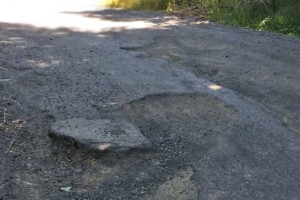
One of many large pot holes on Powerhouse road. It is a single lane with only a couple pullout spots. The author had to put the vehicle in reverse twice due to oncoming cars in the opposite direction.
Problems? What problems? Locals have been going there for years.
Currently, there is only one legal access road for the public to access the Powerdale Corridor without trespassing through private property. This road to the powerhouse is on land now owned by Hood River County, buy they do not maintain the road, nor do they have plans to do so. Due to large potholes, crumbling pavement, and potential wash outs or collapse, the single lane dirt road could soon become impassable, without ongoing maintenance. It is not possible to widen the road due to the steep drop off into the river. It has washed out in the recent past.
Alternative public access roads or trails leading to other parts of the corridor either involve: 1. gaining easements from property owners or 2. steep cliffs which make building near-impossible.
The portable toilet and garbage cans were removed from the powerhouse parking area due to vandalism and difficulty maintaining them.
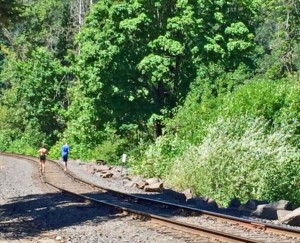
Hikers trespassing on the railroad tracks.
Currently, to get access to the corridor, people frequently walk along the railroad tracks. The Mount Hood Railroad owns the tracks and a 60-foot wide corridor surrounding them. Signs clearly state that walking on or near the tracks is not allowed and considered trespassing. Because there is no alternate route available, people risk collision with a train (albeit slow-moving) by crossing the river via the train trestle.
Ron Kaufman, General Manager of the Mount Hood Railroad voiced concerns at the June 27 meeting about safety of people crossing the trestle as well as erosion of the track bed from walking on it. “You can’t continue to have more and more people without more responsibility,” he said, “but one thing I keep coming back to is that the river is a treasure and I hate to see a position where people are cut off from it.”
Recreation use of the area has notably increased during the past couple years, Conley told the audience, “We really feel like the current level of use calls for more management. We need to step it up and do a bit more – clean up the trash, prevent trespassing.” Key recommendations of the Recreation and Access Plan to maintain public access include maintaining Powerhouse Road, creating a legal railroad crossing and trail easement, development of bridges for public access to beaches, and obtaining easements to enable public access to privately-owned sections of road such as Copper Dam Road. All of which come with seemingly insurmountable problems: cost, cliffs, conflicts with landowners, carrying capacity.
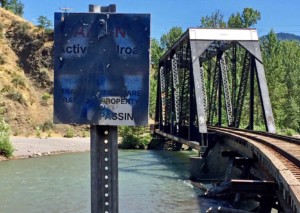
Painted over sign explaining that walking the tracks to cross the river is trespassing.
Not everyone supports increased access to the Powerdale Corridor. A property owner along the corridor complained during the meeting that people were trespassing on her private road which is expensive to maintain. And she added that people frequently swim nude at the swimming hole, despite presence of nearby children.
Illegal camping, potentially sparking wildfires, is a concern. Homeless encampments have been observed. Due to legal issues and lack of resources, problems are difficult to control. If visitor use escalates creating problems for the railroad, Conley said they railroad could restrict access by erecting fences. One of the reasons for creating an access plan is to troubleshoot solutions for all stakeholders and recreational users.
What about native plants and wildlife?
Although this area is slated for low-impact recreation, increased human presence could potentially impact native wildlife due to disturbance, displacement, pollution, and illegal hunting. Remote cameras have captured photos of a variety of mammals using the area including bear, bobcat, coyote, and elk. Harlequin duck, mergansers, dippers, and mallards swim along the river with their ducklings. The riparian area is filled with songs of nesting warblers, sparrows, grosbeaks, and woodpeckers every spring. Salmon, steelhead, bull trout, and lamprey swim upstream freely from the Columbia since the Powerdale Dam was removed in 2010. Restoration work along the Hood River and its tributaries so far includes: invasive plant removal, planting of over 1400 native trees and shrubs, and creating log jam structures to restore the floodplain and provide refuge habitat for juvenile fish.
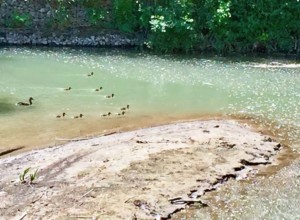
Mallard ducklings below the Powerhouse.
At the meeting, Columbia Land Trust’s Conley made it clear that protecting existing fish and wildlife habitat in the area is the number one goal of the land trust. Other goals include: providing safe legal public access for recreation, education, and preserving tribal fishing rights. All these other goals must complement their Goal #1 to protect terrestrial and aquatic ecosystems within the corridor.
Currently they are tackling each problem as it arises – putting out fires. Conley explained, “The land trust advocates for a more proactive approach.”
“Personally, I want to enjoy nature close to home,” Conley said, “This is a special place. It is important that people who live here have access to the [Hood] river.”
For further information, read The Powerdale Recreation and Access Plan. To comment on the plan, contact Kate Conley of Columbia Land Trust plan or Mikel Diwan at Hood River County Public Works.



